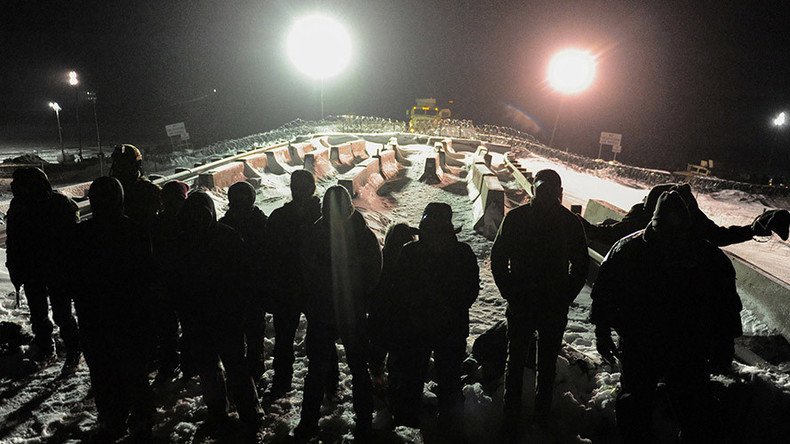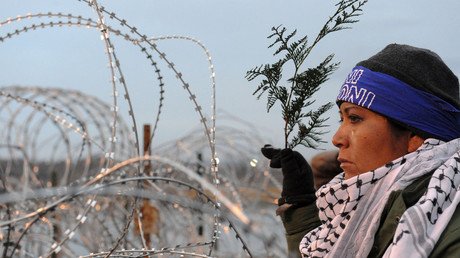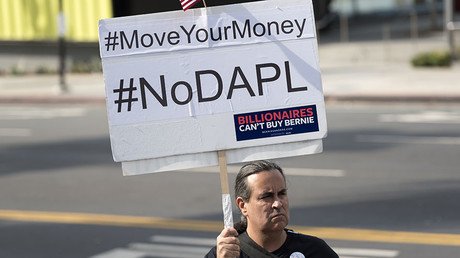‘Wanna burn the US constitution? Shoot at us first’: Veterans prepare to aid DAPL protesters

US military veterans continue to arrive at Standing Rock, with up to 3,500 expected in total. They are due to meet with tribal elders to discuss how they can best help the ongoing protest, marked by heavy police force and bitterly cold weather conditions.
Members of “Veterans Stand for Standing Rock,” who have been told to bring supplies such as gas masks, earplugs and body armor (but no drugs, alcohol or weapons), plan to form a human shield around protesters to protect them against rubber bullets and the police.
“We feel that we have a voice that is unique as many of us have served in overseas deployments,” Brian Trautman of the Veterans for Peace group told RT.
"And in terms of the respect, the honor and the pedestal on which the American people hold veterans, I think we can certainly provide that assistance to the Native American peoples, to bring in the people of the United States into awareness of what’s going on at Standing Rock.”
If what protesters are saying about the level of police violence is to be believed, the veterans’ protection is crucially needed.
“One person got his head split wide open. I’ve got two sons that were shot up with beanbags, which don’t have beans but lead inside,” said Guy Dull Knife, a US Army veteran at the site.
“They’ve been treating us pretty bad, but we’re still here.” On Monday, North Dakota Governor Jack Dalrymple ordered a mandatory evacuation of the area, citing health concerns, meaning anyone who refuses to leave by December 5 risks being arrested. However, the state has denied it has plans for the “forcible removal” of protesters.
In another recent development, the Morton County sheriff’s department has threatened to fine anyone bringing in supplies. This, say protesters, will make the situation even more desperate.
“We have what we need but we don’t have enough. We rely on supply runs,” said protester Keytha Fixico.
Those at the scene believe the National Guard may be called in, potentially escalating the situation. Veterans have already been asked to protest peacefully and avoid confrontations with officers that may get them arrested.
“The veterans are saying we can’t stand for that,” explained filmmaker Josh Fox, who has documented the police force at Standing Rock.
“What you do to the water protectors you do to the United States Constitution. We are sworn to uphold and protect the United States Constitution against all enemies, foreign and domestic. And they’re saying listen, if you wanna burn the United States Constitution, you have to go through us. It’s quite a brave and amazing act that’s never happened in the history of the United States, that two thousand veterans just said you know what? Shoot at us first.”
According to Doug McLean, an environmental activist at the scene, the police have used wildly disproportionate force on peaceful protesters.
“It’s crazy. Being shot with rubber bullets, a woman [Sophia Wilansky] had her arm just about blown off by a concussion grenade, there was tear gas, there was macing of civilians by the police, and we’ve seen the razor wiring of a sacred site that’s very important to the native population here, as well as the use of floodlights all night long which is a psychological warfare tactic, [and] the low surveillance by helicopter and airplanes is also a psychological warfare tactic. It’s just insane what is happening here,” he said.
McLean also described how a fellow protester, an Iraq war veteran, noticed a National Guard general talking with the police.
“This was a Native American veteran who’d served in Iraq in 2005 in the Air Force, and this man was appalled that the military were up on the hill plotting their next move against American citizens on American soil. He called out to the general. He said you’re betraying your oath to the people. You’re betraying your oath to the American people, general. I see you! I see your name, I see your rank, and I’m appalled that you’re doing this.”
Fox is worried that a full-scale deployment of the National Guard will dramatically escalate the situation.
“If the governor were to call in the National Guard, it could potentially be extraordinarily… it would be really bad. I don’t think that those people are leaving, and I think there are many people who are willing to die.”
“For the North Dakota governor to be acting as the aggressor in this situation is in line with 500 years of Native American genocidal history. It is in line with a policy that stole this continent from its original inhabitants,” he added.
The US Army Corps of Engineers, to whom the land under which the pipeline will go belongs, have twice delayed the decision on letting Texas-based Energy Transfer Partners LP, the company behind the pipeline, drill under Lake Oahe, which lies to the east of the Standing Rock reservation. Meanwhile the US federal government has avoided taking a firm stance on the issue, trying to maintain dialogue with all sides.
“We recognize the strong feelings that exist about the Dakota Access pipeline – feelings that in many instances arise from the complicated and painful history between the federal government and American Indians,” US Attorney General Loretta Lynch said in a statement.
“We will remain committed to working with all stakeholders to enforce the law; to maintain the peace; and to reach a just solution to this challenging situation.” However, the federal government was criticized by both sides for failing to take any action.
“While I appreciate the attorney-general taking the time to reach out to me, neither assistance for law enforcement nor a timeline for resolution was offered,” Morton County sheriff Kyle Kirchmeier told the Guardian.
“What real conciliation looks like is giving us all our land back,” said Xhopakelxhi, a Native American protester who has been at Standing Rock since September.
“Why are they so late in the game? They could have stepped in months ago. They could have put a moratorium on construction.”
Some activists are trying to fight back using legal action. Civil rights attorney Rachel Lederman of the National Lawyers Guild is among those filing a class action lawsuit against the North Dakota County Sheriff’s Office, describing the behavior of the authorities as unconstitutional.
“It’s pretty simple. If there’s violations of the law, of course the police are entitled to make arrests. If someone’s attacking the police, of course they’re allowed to use reasonable force to defend themselves,” she explained to RT.
“But to use impact munitions fired from shotguns, explosive grenades [and] water cannons simply to break up a protest or even a prayer ceremony, that’s unconstitutional.”
Protests first erupted over the Dakota Access Pipeline in April, but received little mainstream media coverage until recent months. Critics of the pipeline say it will cut through indigenous land, including sacred burial sites, as well as threaten the local environment and drinking water. The Standing Rock protests are said to be the largest gathering of native peoples in modern American history, involving members of 280 tribes.
Veterans on-site have begun building a makeshift barracks and mess hall near the Oceti Sakowin camp site. However, for those who couldn’t make it to North Dakota there are other ways they can help.
“We ask folks, members of Veterans for Peace, and veterans everywhere and allies of ours to contact their local officials, contact their congresspeople, contact the state of North Dakota and the banks that are funding the Dakota Access pipeline and say that this is wrong,” Brian Trautman told RT.
“All these methods we hope will finally put an end to this pipeline.”
















